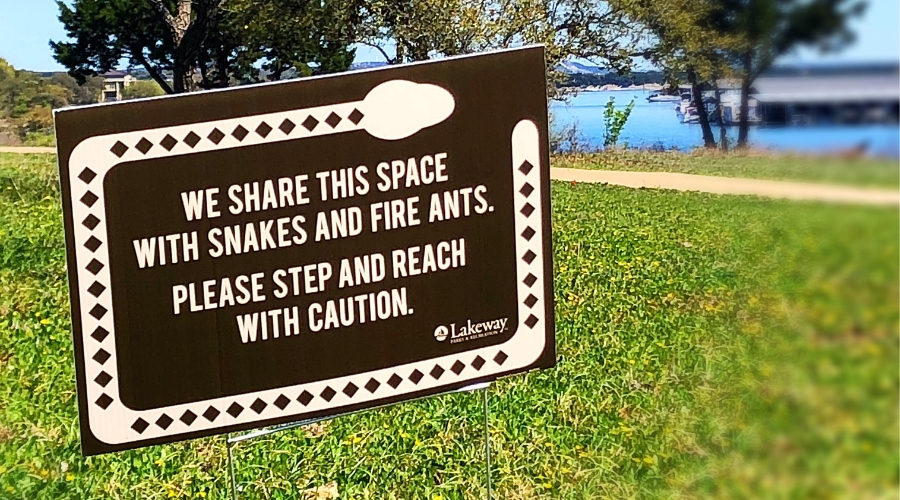If you live in the Lake Travis area, you’ve probably been hearing about all of the recent snake sightings. Just yesterday the words “we killed a 3-foot long copperhead in Point Venture” gave us a good scare. If you’re new to the Texas Hill Country, it’s time to re-evaluate your life choices.
Just kidding! You’ll be fine. If you can handle the fire ants and the scorpions and the mountain lions, you can handle the snakes.
It’s one of the things that makes living in the Hill Country so wonderful — the abundance of nature. But you have to be smart if you live in Texas because there are more than a few critters that you don’t want to mess with. Same goes for your pets.
It’s not just about sneaky scavengers and docile turkeys. There are things that rattle and hiss…
A few years ago, we reached out to the Critterman himself, David Kleven, who has frequented Lake Travis Community Library to teach children and adults about critter safety. David has been featured on the Discovery Network’s Animal Planet and has worked with other famous animal experts like Jack Hanna, Jeff Corwin, and the Kratt brothers.
According to David, the most popular critter people call and email him about is our slithery friend, the snake. Snakes are scary since many of them are poisonous. Then again, many are harmless garden snakes that fear humans as much as we fear them. I had the opportunity to discuss a few critters with David for a quick summertime education:
Know your potentially poisonous fellas
Pit vipers like copperheads, cottonmouths, and rattlesnakes are venomous snakes, as are coral snakes. If you want to brush up on your identification skills, you can check out a list with descriptions from Texas Parks & Wildlife.
There are distinguishing features that can help you determine if a snake is poisonous or not, but there are always caveats. Worried? See below.
Get the rhyme right
Because if you learn it wrong, that’s plain bad. “Red Touch Yellow – Kills a Fellow. Red Touch Black – Venom Lack. Yellow Touches Red – Soon You’ll Be Dead. Red Touches Black – Friend of Jack.” And if you aren’t a poet and you know it, follow Critterman’s advice below.
Pay attention when walking
“The majority of incidents where a person gets bitten by a snake is because they weren’t paying attention to where they were walking,” says David. “This is Texas! Those snakes were here long before we were, so we need to know how to live with them because they aren’t going anywhere.”
Cover those toes
David says you have to be smart and keep your eyes open. Watch where you’re going. Literally! “That’s why Texans have cowboy boots,” Kleven laughs.
Cowboy boots are the perfect type of protection for your feet and lower legs if you’re outside working or camping or exploring, so if you do encounter a snake, you’re a lot better off.
Protecting your pets
Most of our four-legged friends can’t wear cowboy boots, so … how do we protect them?
Snakes don’t tend to be aggressive unless they’re injured or feel threatened. The best thing you can do with an outdoor pet is to remove any potential hiding spots for snakes like a pile of leaves in a shady corner of the yard and keep an eye on Spot’s doghouse.
David says snakes don’t like wide-open spaces, so they tend to stay hidden. The fewer hiding spots they have near your pet, the better.
A snake with your snail mail
A few years ago, one of my neighbors found a small snake in her mailbox with her mail, and a few days ago, we opened the mailbox to find a scorpion. Yikes!
I asked Critterman if it seems odd to find a snake in the mailbox. To my dismay, he said snakes can climb almost anything with texture. “Snakes can certainly climb straight up a brick encased mailbox and crawl right into an open mailbox. And, of course, scorpions are sneaky little critters that can wiggle into a cool space too.
Don’t forget the scorpions
Ranking right up there on the fear factor with fire ants is our predatory arthropod pals, scorpions. The Hill Country is home to many types of scorpions from small dark-colored ones to larger whitish-clear ones.
They do strike and produce a nasty sting, but unlike bees, they leave no stinger behind. Unless you are allergic to certain insect bites, Kleven says the scorpion sting is much like a wasp sting. You can treat it with antiseptic and take oral anti-histamine to reduce side effects.
On the bright side
An interesting factoid about scorpions is they glow. Scorpions have a chemical in their exoskeleton, so if you were to shine an ultraviolet light on one, it would glow a vibrant blue-green. Who wants to go outside tonight and test that theory?
What’s the creepiest critter you’ve seen this summer?
Editor’s note: This article was originally published in 2014, but updated with new information in May 2019.
